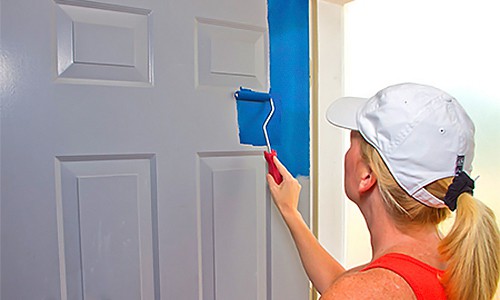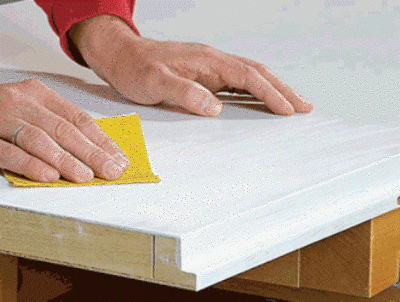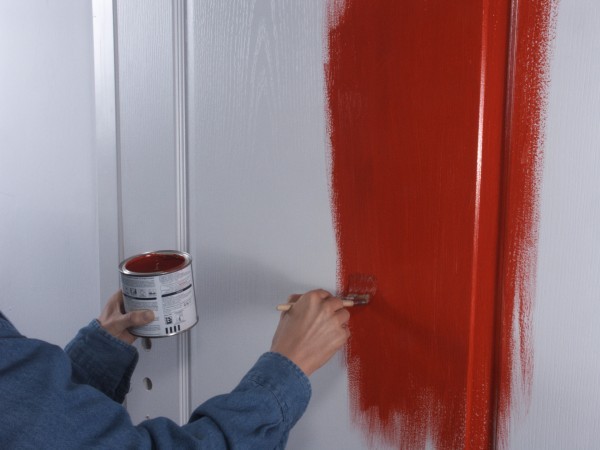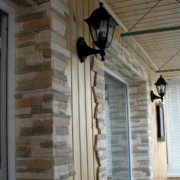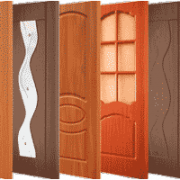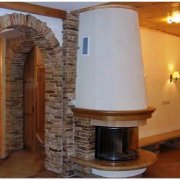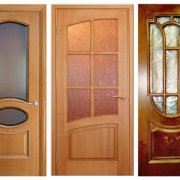We prepare interior doors for painting
Painting interior doors is done quite often at the beginning of the repair. After all, no matter what quality the door is, after a certain amount of time, it loses its original impeccable appearance.
With prolonged use due to scratches, chips, tarnishing of the paintwork, loosening of hinges, doors lose their chic. And if before the repair work in the apartment, it was not so noticeable, then after the changed appearance of the interior, the door needs a new painting or a complete replacement.
Today we will tell you how to paint interior doors.
The content of the article
We do the painting ourselves
In principle, all work can be done completely independently. Then the final price will not be significant.
Interior door painting do it yourself is not complicated, you just need to choose the right dye and apply it according to the technology. Below we will consider all this in detail, as you will be presented with a video in this article and photos that will greatly facilitate the work.
Preparatory work before painting the old door leaf
Any repair requires expensive materials, complicated equipment and tools, and to update the door leaf it is enough to have simple painting skills and ordinary tools.
Attention: immediately you need to look at the door material. It can be pine interior doors for painting or chipboard is also used. In each case there will be a variant of the preparation of the plane.
So:
- When all the work is done according to technology, carefully and competently, it will not be possible to distinguish the old door from the new one, especially when replacing accessories. In addition, with the old door, it is not so scary to try your creative abilities for beginners in the repair. And you can make the doors original to your taste without paying a lot of money.
- Replacing locks and hinges can be done together with a more experienced specialist, or exercise, secluded alone. Moreover, it will not be so difficult to change hinges and handles, since there will be no need to make new holes for them in the door, subject to all sizes.
Attention: If the old fittings will not fit for the new fittings, then it should have wider overlays to hide old defects.
Thus, before transforming the doors, you should decide on its appearance, choose the necessary finish or color.
- If there are no serious flaws at the door, they are often painted standing up, without resorting to removal from the hinges, laying paper or newspapers on the floor. All this is done quickly, defects are not eliminated, dents are not putty (see Hard putty on wood: how to do it wisely) Everything is painted over the old layer. Such coloring contributes to the formation of sagging and smudges, and the doors will not have a presentable appearance.
- Sometimes there is a problem of removing the doors from the hinges, as they were installed simultaneously with the box. Therefore, they produce such an incorrect staining. No need to remove sliding door leafs. First, one of the surfaces of such doors is painted, evenly distributing the quick-drying coloring material with a roller.
- When restoring and painting old door leafs, they must first of all be removed from the hinges and dismantled accessories.If it is difficult to unscrew the hinges and handles, then you can seal them with masking tape. Scotch tape is removed after the paint is completely dry. A keyhole is best plugged with cotton.
Attention: If there are inserts at the door, elements in the form of complex figures must be pasted over completely with tape, and if they are rectangular in shape - around the perimeter. At the same time, this must be done from two sides.
- If the door is painted in several layers, then it does not look very aesthetically pleasing. Therefore, old paint must be removed. There are several methods for this, for example using a blowtorch or a building hair dryer, which serve to heat old paint with a layer. Next, with a sharp tool, remove and clean up the sandpaper of the old layers. This old way has not been used by experienced professionals for a long time. The paint still remains in small crevices, in addition, burnt paint has a corresponding unbearable odor, and such work can only be done on the street.
- To date, there are special fluids that perfectly remove paint (see How to remove old paint from wood without problems), but they have a specific smell, and such washes are not suitable for any paint. A similar mixture can be made independently, for example, taking as a basis a solvent and caustic soda. This composition softens the paint well, and then it is easily removed with a spatula.
- It is also possible to process a smooth door leaf with a grinder or with special tools. Then the door is treated with fine-grained sandpaper. And then puttying of defects and depressions is done with a special primer, especially when painting with glossy paint. For different types of paint, it is necessary to select the appropriate primer. Thanks to it, the doors are qualitatively and evenly coated with varnish or enamel.
Caution: It is necessary that the new paint composition has compatibility with old coatings and primers. Otherwise, an adverse reaction may occur and everything will go bad!
To repaint the old door you must have:
- At least one liter of paint, as well as a solvent;
- Two to three brushes for painting, wide and narrow; a container for receiving a liquid mixture and a stick for mixing;
- Rollers;
- Sandpaper;
- Sponges and cotton;
- Masking tape;
- Paper for flooring; to
- Pencils, a ruler of metal;
- Level and bars.
The best way to get a quality coating is to paint on a flawless horizontal surface.
How to choose paints
For painting doors, you can use the following types of paints:
| Alkyd Enamels | They are one of the common and available materials for coloring. They have a rich palette that allows you to choose the appropriate color for the interior design. Allow to make excellent coloring in one - two layers. The disadvantages include a rather pungent odor, which disappears after about two to three days. |
| Universal acrylic paint | Suitable for home dyeing, as it does not have a pungent odor. But the financial cost of painting will be more expensive, especially given the staining in two layers. The main advantages are a rich color scheme and a smooth surface. But at the same time, the coloring material is not resistant to mechanical damage, and it needs to be fixed with varnish. |
| Nitro enamels | The most popular domestic paint for doors is nitro paint. The surface painted by it will be smooth and shiny, but it has an expensive price and an intolerable smell when painting. |
Caution: It is not necessary to paint the new wooden door. Covered with colorless or colored varnish, it will have an excellent appearance, especially if the varnish is applied in layers.
How to choose a paint
Taking into account personal preferences when choosing a coloring composition, it is still necessary to have information about the properties of this material:
- Latex paints can be applied to oil paints, and acrylic-based enamels on water-based paints;
- The matte surface allows you to hide fingerprints from the hands;
- On a glossy surface, despite the excellent appearance, all defects that are on a wooden canvas are clearly visible;
- Semi-gloss acrylic painting materials are suitable for any type of indoor door;
- The advantage of latex enamels is their resistance to mechanical damage, but they are very reminiscent of ordinary oil paint.
The process of painting the door with paints
Interior doors for painting after careful preparation are ready for the application of dye.
Everything is done as follows:
- The first thing a can with a coloring composition is opening neatly, with his hands out in gloves, and in order not to breathe fumes it is better to wear a respirator.
- Next, pour a little paint into an empty container to dilute it with solvent. Now you need to stir the composition with a stick to the consistency of liquid sour cream.
- A smooth new surface should be painted with liquid paint, distributing it with a roller. But too liquid composition will give omissions, and viscous - irregularities. Therefore, first, for the test, it is necessary to make 2-3 strokes, then adjust the composition to the required viscosity.
- In hard-to-reach places, you can use thin brushes, and quickly smooth the smooth surface with a roller. If the paint shines in places, you will need to paint a second coat. Moreover, the painting in two layers is better.
- During the painting process, the composition must be stirred periodically so that heavy particles settle. Work with a roller occurs horizontally and vertically, and brushes paint the fabric along the fibers.
- After fully painting the doors on one side, they wait until it is completely dry. And then, turning over, they paint the other side, not forgetting to process the ends that are painted in a small layer so that the door leaf does not jam in the box.
- In order not to distort the texture, it is necessary to paint with a brush along the fibers. Although after the first coat, a smooth wooden coating may become rougher, since the fibers will swell and they will be slightly tousled. Thanks to the second coating layer, the fibers are smoothed out and the indentations between them are filled. If necessary, before re-staining, you can remove rough spots with sandpaper.
- So that the grains and villi do not move and do not stick, the bristles on the new brush are sorted out, soaked in water, washed in a solvent and worked with it for some time without coloring material.
- The fittings are installed when the door leaf is completely dry.
- Staining of the door leaf that has not been removed from the hinges must be done from top to bottom, and horizontally - from the middle to the edge.
Attention: When painting the door with specialists, the cost consists of the time spent and the double price of the paint. This also includes the drying period, so it is more economical to carry out dyeing work yourself.
Covering the door leaf with varnish for wood
The varnish is an oily or transparent base, which includes resins, polymers and solvents. It perfectly covers wood, emphasizing the pattern of wood fibers. In addition, thanks to the varnish, the wooden coating will be reliably protected from temperature and humidity.
There are several types of varnish when working indoors and outdoors.
In appearance of the varnish coating, varnishes are:
- High glossy;
- Glossy
- Semi glossy;
- Semi matte;
- Matt
There are also colored varnishes with a certain color. In addition, there are varnishes for furniture, parquet, universal.
Updating doors using original design methods:
- Coloring the door in two to three colors. In this case, a coating of the primary color is required. For this beautiful reception, among other things, you must have the skill, have thin brushes and masking tape.
- A door with an original design will become an adornment of a kitchen or children's room, but do not forget about the general design of the room. Such original techniques can be various landscapes or ornaments on the door leaf.
- Spectacular textures will look interesting. For example, made: in the form of denim, compressed foil, large strokes, a porous sponge.
- If you have artistic talents, then you can do the exclusive decoration of the door leaf. Especially if you are planning a family holiday. On the doors you can place a pattern in the form of a twisted heart with the corresponding initials.
Do you make hidden interior doors for painting or any other, the most important is the correct preparation for painting. Indeed, it affects the durability and appearance of the coating. The instruction will help you do everything correctly and efficiently.
